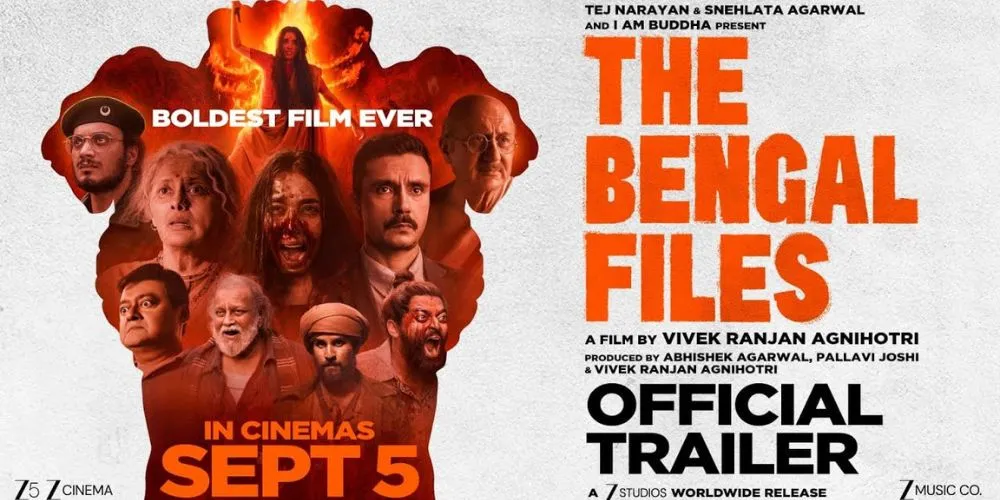When a filmmaker’s voice is stifled not by critics, but by sudden disruptions at a public trailer launch, questions about censorship and freedom of expression come to the fore. That is exactly what happened recently in Kolkata, where director Vivek Agnihotri staged The Bengal Files trailer event—only to face unexpected roadblocks involving power cuts, police intervention, and allegations of political interference. This blog dives deep into the controversy, unpacking narrative layers, responses, and broader implications for art and politics.
1. The Build-Up: A Screening Scrubbed
Agnihotri’s team initially planned a grand premiere at a leading movie multiplex in Kolkata. According to the director, this venue backed out at the last minute—he alleges under “political pressure.” With only hours to go and no alternative, he scrambled to secure a backup location: a banquet hall at the ITC Royal Bengal hotel. The director claimed, “All the screens have been put up, all tests have been conducted… now at the last minute they are saying we cannot screen it.”The Indian ExpressIndia Today
2. Disruptions at the Hotel: Power Cuts and Police Presence
The hotel event was short-lived. Agnihotri alleges that wires were intentionally cut, bringing the trailer screening to a halt. “Some people came and cut all the wires,” he asserted, calling the interference “autocracy” and “dictatorship.”The Times of IndiaHindustan TimesThe Indian Express He added that a large contingent of Kolkata Police was deployed inside and outside the venue, and even the laptop meant for screening was seized.The Indian Express
3. The I’ve-Got-Permissions Claim vs. Police Version
Agnihotri insisted he had all necessary permissions for the screening. But Kolkata Police painted a different storyboard—saying no prior approval was granted. They cited the West Bengal Cinemas (Regulation) Act, 1954, under which public screenings require specific permissions, which, according to officers, had not been obtained.www.ndtv.commintIndia Today The hotel management, meanwhile, stated it had fully cooperated and shared all information with authorities.The Times of India
4. Artistic Expression vs. Political Allegations
The film’s co-producer and actor Pallavi Joshi was vocal in defense of artistic freedom. “Is there freedom of expression in this state?” she demanded. “Such a thing did not happen even in Kashmir.”Hindustan TimesThe Indian Express
On the flip side, TMC spokesperson Kunal Ghosh dismissed the claims as politically motivated theatrics. He challenged Agnihotri to turn his lens on tragedies in BJP-ruled states instead. “Why hasn’t he made Gujarat Files or Manipur Files yet? He has come here [to Bengal] only to malign us,” Ghosh said.The Times of IndiaIndia Today
5. The Trailer Did Go Live—Online
Despite disruptions, the trailer eventually reached the public—via YouTube and other digital platforms. It marked the culmination of a chaotic few hours and spokespersons reaffirmed that artistic voices, though challenged, eventually found an outlet.New India AbroadIndia Today
6. Context: The Bengal Files and Its Legacy
The Bengal Files is the latest offering from Agnihotri’s “Files Trilogy,” tracing historical and political narratives—this time focusing on the 1946 Great Calcutta Killings (also known as Direct Action Day) and the subsequent communal fallout. The film stars heavyweights like Mithun Chakraborty, Anupam Kher, and Pallavi Joshi, and is slated for theatrical release on September 5, 2025.Wikipedia
Agnihotri’s previous works—including The Kashmir Files—have courted controversy, often shadowed with debates about artistic license, historical narrative, and political alignment.
7. Broader Implications and Takeaways
- Freedom of Expression Under Scrutiny: The power cut and police entry bring concerns about whether filmmakers can speak freely—especially in regions with charged political climates.
- Rule of Law or Political Pressure? Discrepancies between the director’s claims of full permissions and the police’s counter-narrative spotlight confusion—or worse, selective enforcement of regulations.
- Digital Platforms as Refuge: When public events falter, creators increasingly rely on the internet to bypass gatekeepers and reach audiences directly.
- Culture vs. Politics: Tensions between storytellers and ruling establishments raise questions about whether art is being weaponized—or silenced—for political messaging.
Conclusion
The trailer launch of The Bengal Files in Kolkata became more than a promotional event—it swiftly turned into a flashpoint for debates around censorship, legal mandates, and creative freedom. While Agnihotri called it “anarchy,” opponents labeled it propaganda. Regardless of political leanings, the incident has reignited vital discussions on who gets to tell our stories—and how.
As the film gears up for its release, this controversy only amplifies its visibility. But beneath the drama lies a larger question: In democratic India, whose voice gets heard—and whose is denied?










